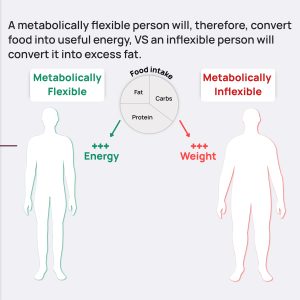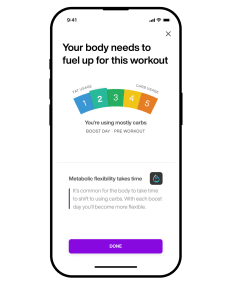Hello Friends!
Now at The WHOLESTIC Method Coaching program, we are offering access to Lumen, a metabolic device you can bring with you anywhere that is helping our clients achieve weight loss, enhance athletic performance and improve overall metabolic health.
SAVE 10% on your LUMEN device with my coupon code: COACHDEBBIE
Why invest in another device??
Use Lumen to increase your metabolic flexibility.
- The beauty of metabolic flexibility is that it’s not a fixed trait; research shows that a flexible metabolism can improve your overall health through changes in your lifestyle like regular exercise, and quality sleep.
- Follow your nutrition plan each day to improve your metabolic flexibility and keep track of your progress by taking morning measurements.
Improved Weight Loss
- Good metabolic flexibility allows your body to efficiently switch between different fuel sources for energy, including stored fat.
- As a result, this can make it easier to lose weight and achieve optimal body composition.

Greater Energy Levels
- With good metabolic flexibility, you may experience more stable and greater energy levels throughout the day and have an easier time maintaining your energy levels during prolonged exercise and physical activity.
Plan When to Eat Your Carbs from Nature
- Developing good metabolic flexibility may help to prevent chronic diseases and support long-term health and well-being, allowing you to enjoy a healthier, happier life
- Remember that everyone’s journey is different, and your metabolism and nutrition needs are unique, which is why your personalized nutrition plan is crucial to achieving your goals.
The Lumen device measures your current metabolic state.
Lumen uses a range of 5 levels to indicate whether your body is burning mostly fats, carbs, or a
combination of the two for energy.
A Lumen level of 1 or 2 indicates that your body mainly uses fat for energy (more than 84% fat, and 63-84% fat respectively).
You should strive to receive a level 1 or 2 upon waking or after a fast.
After a meal (1-2 hours) you ideally would want to see an increase in your Lumen levels. This illustrates that you are using carbs for fuel after consuming
them.
After a workout (~40 mins) you should strive for a decrease in your Lumen
levels. This illustrates that you’ve used carbohydrates available for fuel to
power your activity.
Level 3 means that your body is using carbs and fats relatively equally (42-63% fats).

Levels 4 or 5 mean that your body primarily burns carbs for fuel (60-80% carbs,
and more than 80% respectively).
It is important to note that there are no “good” or “bad” Lumen levels and that we should not strive to see Lumen levels 1 or 2 consistently.
Use this unique link for $100 off your purchase.
- The best part about it – we can help by monitoring your data!
- Purchasing a Lumen through The WHOLIESTIC Method- Debbie Potts Coaching program will allow you to opt into additional coaching sessions.
- Let our team support you and guide you through your metabolic journey.
- Ask Coach Debbie about her six-month packages for personalized coaching programs as low as $297 per month:
- The Assessment Package (Bronze)
- The Accountability Package (Silver)

- The Health Investigation Package (Gold)
- The Longevity VIP Package (Platinum)
The Lumen Goal
Lumen’s goal is to help you master your metabolism. Almost all bodily functions depend on metabolism! Metabolism involves a large sum of chemical reactions to produce or consume energy. Blood pressure regulation, muscle growth, immune system support, appetite regulation – all these functions rely on our metabolism.
With Lumen, you will work towards becoming metabolically flexible. This flexibility indicates that your body properly utilizes carbs and fats for energy. An efficient metabolism will allow you to use whichever fuel source is available (fats or carbs).
The goal with Lumen is to train your body to burn carbs when they are consumed (i.e after a meal, reflected in an increase of a Lumen level), and to burn fats when you’ve depleted all your carb stores (i.e. after an overnight fast during sleep, reflected in a low Lumen level). Alternating between carbs and fats as sources of metabolic fuel will, over time, teach the body to use both for energy, resulting in a more flexible and efficient metabolism.
Training your metabolism takes time.
Each person’s metabolism is unique and we start our Lumen journey at varying levels of flexibility. Aim to improve your metabolic score with patience, consistency and effort in following your plan. As you increase your metabolic flexibility, you’ll notice the benefits that come along with it to your overall health. Lastly, extra benefits are available to you!
Because you purchased your Lumen through your Practitioner, you will be able to share your metabolic data directly with them. We encourage you to consult with them on your Lumen levels for additional coaching or support.
Be sure to use our unique discount link you can distribute: The WHOLESTIC Method LUMEN Code Here
To learn how to manipulate macronutrients based on fuel source burn using a Lumen breath test and understanding your metabolic state, follow these steps:
Understanding the Basics
- Macronutrients and Their Roles:
- Carbohydrates: Quick energy source, primarily used during high-intensity activities.
- Proteins: Essential for muscle repair and growth, can be used as an energy source in the absence of carbs and fats.
- Fats: Long-lasting energy source, especially during low-intensity or prolonged activities.
- Lumen Device:

- Measures the concentration of CO2 in your breath, which indicates whether your body is burning fats or carbohydrates for energy.
- Provides insights into your metabolic flexibility and can help tailor your nutrition and exercise plan.
Steps to Manipulate Macronutrients Based on Lumen Readings
Initial Assessment:
-
- Use the Lumen device to measure your breath at various times of the day (morning, before and after meals, and before and after workouts) to understand your baseline metabolic state.
Interpreting Lumen Scores:
-
- Score 1-2: Primarily burning fat.
- Score 3-4: Mixed fuel usage.
- Score 4-5: Primarily burning carbohydrates.
Adjusting Macronutrients:
-
- High Carbohydrate Burn (Score 4-5):
- Reduce carbohydrate intake: Aim to lower carb intake, especially refined carbs and sugars.
- Increase fat intake: Incorporate healthy fats like avocados, nuts, and olive oil.
- Moderate protein intake: Ensure adequate protein to maintain muscle mass but don’t overdo it.
- Mixed Fuel Usage (Score 3-4):
- Balanced macronutrient intake: Maintain a balance of carbs, fats, and proteins.
- Focus on complex carbs: Include whole grains, vegetables, and legumes.
- Monitor meal timing: Distribute macronutrients evenly throughout the day.
- High Fat Burn (Score 1-2):
- Increase carbohydrate intake: Introduce more carbs, focusing on complex carbohydrates.
- Moderate fat intake: Keep fat intake moderate to avoid overwhelming your system with fats.
- Maintain protein intake: Continue with a balanced protein intake to support muscle maintenance.
- High Carbohydrate Burn (Score 4-5):
Fine-Tuning Based on Activity Level:
-
-
-
- High-Intensity Activities:
- Increase carbohydrate intake before and after workouts to replenish glycogen stores.
- Reduce fat intake before workouts to avoid sluggishness.
- Low-Intensity Activities:

- Maintain higher fat intake as a primary energy source.
- Keep carbohydrates lower, focusing on maintaining a steady energy level.
- High-Intensity Activities:
-
-
Meal Timing and Composition:
-
- Morning (Post-Fasting):
- If burning fat, start with a low-carb, high-fat meal.
- If burning carbs, a balanced breakfast with carbs and proteins is ideal.
- Pre-Workout:
- Carbohydrate intake to fuel the workout if you’re burning carbs.
- Protein and some fats if you’re in a fat-burning state.
- Post-Workout:
- Higher protein and carbs to aid recovery and replenish glycogen stores.
- Moderate fats to ensure nutrient absorption.
- Morning (Post-Fasting):
Monitoring and Adjusting:
-
- Regularly use the Lumen device to track changes in your metabolic state.
- Adjust macronutrient intake based on daily readings and activity levels.
- Experiment with different macronutrient ratios and meal timings to see what works best for your body.
Additional Lumen Tips
- Hydration: Ensure adequate water intake to support metabolic processes.
- Sleep: Quality sleep impacts metabolic health and macronutrient utilization.
- Consistency: Consistent monitoring and adjustments are key to finding what works best for your metabolism.
Example Lumen Plan
- Morning Lumen Score 1-2:
- Breakfast: Avocado and eggs (low carb, high fat, moderate protein).
- Midday Lumen Score 3-4:
- Lunch: Grilled chicken salad with quinoa (balanced macros).
- Pre-Workout Lumen Score 4-5:
- Snack: Banana and almond butter (high carb, moderate fat).
- Post-Workout Lumen Score 3-4:
- Dinner: Salmon with sweet potato and steamed veggies (balanced macros).
By closely monitoring your metabolic state using the Lumen device and adjusting your macronutrient intake accordingly, you can optimize your energy levels, enhance performance, and support overall health.
Stimulating the mitochondria to burn more fat involves optimizing your lifestyle and diet to enhance mitochondrial function and increase metabolic rate.
Here are several strategies to achieve improved mitochondria function to burn fat:
Dietary Strategies
- Balanced Macronutrients: Ensure your diet includes a balanced intake of macronutrients—protein, healthy fats, and complex carbohydrates.
- High-Quality Fats: Include sources of healthy fats such as avocados, nuts, seeds, olive oil, and fatty fish to support mitochondrial function and fat metabolism.
- Protein-Rich Foods: Consume adequate protein to support muscle mass and metabolic rate. Sources include lean meats, poultry, fish, eggs, dairy (if tolerated), and plant-based proteins.
- Fiber-Rich Foods: Integrate high-fiber foods like vegetables and fruits, legumes to support gut health and metabolic processes.
- Ketogenic or Low-Carb Diet: Consider a low-carb or ketogenic diet which can increase fat burning and improve mitochondrial efficiency by promoting ketone production.
- Intermittent Fasting: Incorporate intermittent fasting, which can enhance fat burning and improve metabolic flexibility by increasing the period your body spends in a fat-burning state.
Optimize Your Diet
-
- Healthy Fats: Include sources of healthy fats such as avocados, nuts, seeds, and olive oil. These fats can help improve mitochondrial function.
- Protein Intake: Consuming adequate protein supports muscle maintenance and growth, which in turn can enhance fat metabolism.
- Complex Carbohydrates: Focus on vegetables, and fruits, which provide steady energy and support mitochondrial efficiency.
- Mitochondria-Boosting Nutrients:
- Coenzyme Q10 (CoQ10): Found in beef, chicken, and certain vegetables, it helps with mitochondrial energy production.
- Omega-3 Fatty Acids: Found in fatty fish, flaxseeds, and walnuts, these can enhance mitochondrial function.
- Antioxidants: Foods rich in antioxidants, like berries, dark chocolate, and green tea, protect mitochondria from oxidative damage.
Exercise and Physical Activity
- Aerobic Exercise: Engage in regular aerobic exercise such as walking, running, cycling, or swimming to increase mitochondrial density and enhance fat oxidation.
- Strength Training: Include resistance training to build muscle mass, which can boost your resting metabolic rate and improve insulin sensitivity.
- High-Intensity Interval Training (HIIT): HIIT workouts can improve mitochondrial function, increase metabolic flexibility, and promote fat loss.
Lifestyle Modifications
- Adequate Sleep: Ensure you get 7-9 hours of quality sleep per night. Poor sleep can negatively affect metabolic health and fat metabolism.
- Stress Management: Practice stress-reducing activities such as meditation, yoga, deep breathing exercises, or spending time in nature. Chronic stress can hinder metabolic flexibility and fat loss.
- Hydration: Stay well-hydrated, as dehydration can impair metabolic processes.
Nutritional Supplements
- Omega-3 Fatty Acids: Consider omega-3 supplements, such as fish oil, which can support mitochondrial function and improve fat metabolism.
- Coenzyme Q10: This antioxidant supports mitochondrial function and energy production.
- L-Carnitine: Helps transport fatty acids into the mitochondria for energy production.
- Alpha-Lipoic Acid: An antioxidant that can enhance mitochondrial function and improve insulin sensitivity.
Gut Health
- Probiotics and Prebiotics: Support gut health with probiotics (found in fermented foods like yogurt, kefir, sauerkraut) and prebiotics (found in foods like garlic, onions, and bananas), which can improve overall metabolic health.
Intermittent Fasting
- Fasting periods can enhance mitochondrial biogenesis (the process by which new mitochondria are formed) and improve metabolic flexibility, making your body more efficient at burning fat.
Cold Exposure
- Regular exposure to cold temperatures, such as through cold showers or cryotherapy, can increase the number of mitochondria in brown fat cells, boosting fat burning.
Optimize Sleep and Reduce Stress
- Quality Sleep: Poor sleep can impair mitochondrial function and metabolism. Aim for 7-9 hours of quality sleep per night.
- Stress Management: Chronic stress can negatively impact mitochondrial function. Practices like yoga, meditation, and deep breathing can help reduce stress levels.
Supplements
- CoQ10: Supports mitochondrial energy production.
- Alpha-Lipoic Acid: An antioxidant that can improve mitochondrial function.
- Acetyl-L-Carnitine: Helps transport fatty acids into mitochondria for energy production.
- Resveratrol: Found in red wine and grapes, it may improve mitochondrial function and support fat metabolism.
 Caloric Restriction
Caloric Restriction
- Moderate caloric restriction without malnutrition has been shown to enhance mitochondrial efficiency and increase fat oxidation.
Avoid Toxins
- Reduce exposure to environmental toxins like pesticides, heavy metals, and pollutants, which can impair mitochondrial function. Eating organic foods and using natural cleaning products can help minimize exposure.
Implementing these strategies can help stimulate your mitochondria to burn more fat, enhancing your overall metabolic health and energy levels.


